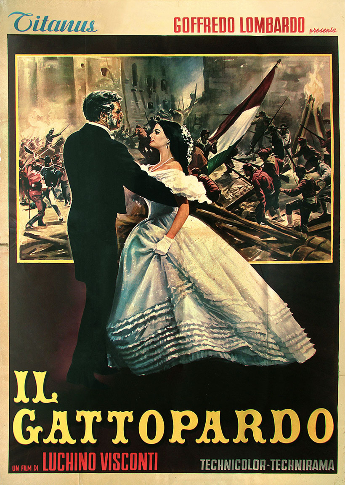“One of the greatest visual experiences in the history of cinema” (Martin Scorsese)
One of the indisputable masterpieces of world cinema gets a new life thanks to a restoration that brings back its original beauty
Martin Scorsese, through his Film Foundation, was the driving force behind the restoration of Il Gattopardo. He defined the film as “one of the greatest visual experiences in the history of cinema.” Luchino Visconti committed to film a unique fusion of art, history and thought. The novel by Giuseppe Tomasi di Lampedusa gives the director the opportunity to develop his personal version of Proust’s recherche, in a maze of light and shadow, full of Verga’s fatalist realism. Il Gattopardo is draped in a funeral pall. Probably the most famous line in the film, “in order for things to stay the same, everything must change”, is spoken as if engraved on a tombstone. It is not just a historical examination of a country at the mercy of unbreakable traditions, it is also a vision that transcends the moment and echoes a universal sentiment. According to Scorsese, Il Gattopardo is “an astonishing cinematic tapestry in which every gesture, every word, the placing of every object in every room brings a lost world to life.” For each of the main actors, this film made an indelible mark on their illustrious careers. Goffredo Lombardo fought hard to get the film made, and despite production costs that nearly ruined Titanus, Il Gattopardo is today considered its greatest ever production, a place where art and spectacle meet to tell a story with indelible strokes.
May 1860. Following the landing of Garibaldi and his forces at Marsala, Don Fabrizio observes with detachment and melancholy the end of the Sicilian aristocracy and the rise of a new social class destined to take power. Like every year, Don Fabrizio, from an old aristocratic family, takes his family to their summer residence at Donnafugata. The new mayor is Calogero Sedara, a poorly educated member of the bourgeoisie, a nouveau riche who takes advantage of the changing times to advance his political career. Tancredi, Don Fabrizio’s favourite nephew, is engaged to Angelica, the daughter of Sedara. She is beautiful and comes from a rich family.
The film was digitally restored by Cineteca di Bologna, in collaboration with Titanus, The Film Foundation, Pathé, Fondation Jérôme Seydoux-Pathé, Twentieth Century Fox and Centro Sperimentale di Cinematografia-Cineteca Nazionale, with the support of Gucci, The Film Foundation, Digital Picture Restoration and Colorworks. The restoration work was carried out by L’Immagine Ritrovata laboratory.
“One of the greatest visual experiences in the history of cinema” (Martin Scorsese)
One of the indisputable masterpieces of world cinema gets a new life thanks to a restoration that brings back its original beauty
Martin Scorsese, through his Film Foundation, was the driving force behind the restoration of Il Gattopardo. He defined the film as “one of the greatest visual experiences in the history of cinema.” Luchino Visconti committed to film a unique fusion of art, history and thought. The novel by Giuseppe Tomasi di Lampedusa gives the director the opportunity to develop his personal version of Proust’s recherche, in a maze of light and shadow, full of Verga’s fatalist realism. Il Gattopardo is draped in a funeral pall. Probably the most famous line in the film, “in order for things to stay the same, everything must change”, is spoken as if engraved on a tombstone. It is not just a historical examination of a country at the mercy of unbreakable traditions, it is also a vision that transcends the moment and echoes a universal sentiment. According to Scorsese, Il Gattopardo is “an astonishing cinematic tapestry in which every gesture, every word, the placing of every object in every room brings a lost world to life.” For each of the main actors, this film made an indelible mark on their illustrious careers. Goffredo Lombardo fought hard to get the film made, and despite production costs that nearly ruined Titanus, Il Gattopardo is today considered its greatest ever production, a place where art and spectacle meet to tell a story with indelible strokes.
May 1860. Following the landing of Garibaldi and his forces at Marsala, Don Fabrizio observes with detachment and melancholy the end of the Sicilian aristocracy and the rise of a new social class destined to take power. Like every year, Don Fabrizio, from an old aristocratic family, takes his family to their summer residence at Donnafugata. The new mayor is Calogero Sedara, a poorly educated member of the bourgeoisie, a nouveau riche who takes advantage of the changing times to advance his political career. Tancredi, Don Fabrizio’s favourite nephew, is engaged to Angelica, the daughter of Sedara. She is beautiful and comes from a rich family.
The film was digitally restored by Cineteca di Bologna, in collaboration with Titanus, The Film Foundation, Pathé, Fondation Jérôme Seydoux-Pathé, Twentieth Century Fox and Centro Sperimentale di Cinematografia-Cineteca Nazionale, with the support of Gucci, The Film Foundation, Digital Picture Restoration and Colorworks. The restoration work was carried out by L’Immagine Ritrovata laboratory.
